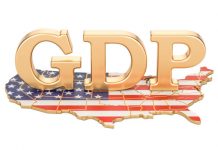Market reaction to US tariff news has been intense, and volatile. It pays to keep your head in the face of such volatility, but some of the repricing could be helpful.
If you think your newsfeed is wild, check out an intra-day graph of the exchange rate.
It was always obvious that the Trump administration would impose tariffs: they were a major plank of his campaign. The details matter, though, so financial market pricing has been sensitive to any news about specific tariff plans. The early targeting of the US’s nearest neighbours was a bit of a surprise and shows that US trade policy cannot be shoehorned neatly into a framework emphasising US–China rivalry, the way it could under Biden.
As is usually the case, policy uncertainty produces a ‘risk off’ tone in markets, resulting in a sell-off in the Australian dollar and other currencies, as investors pile into USD-denominated assets. And of course much of this reversed when the measures against Canada and Mexico were subsequently delayed. The unceasing flow of headlines shows up in market pricing, and this is likely to remain the case.
It’s all too easy to catastrophise about the disruptions to trade and global growth from escalating tariffs. While they can be disruptive, it is also important to recognise that countries and companies can adapt, respond, and route around constraints. If one country imposes tariffs on your exports, there are always other places you can sell them, perhaps at a lower price. As Westpac Senior Economist Mantas Vanagas points out today in a separate note, the scope to redirect trade is greater for a country like Australia that mostly exports commodities.
Some historical perspective is useful here. During the Asian Financial Crisis of the late 1990s, many observers were concerned about the loss of demand for Australia’s exports from the region. It turned out that much of this production was able to be redirected to entirely new destinations such as the Middle East. More recently, when China stopped all coal imports from Australia, our exports were again rerouted elsewhere, to markets that had previously bought coal from the other producer nations that were now selling to China.
Redirecting trade in this way does become harder when a product is designed to cater to the specific consumer tastes or regulations of one market – think certain kinds of seafood or medications – or where one country dominates global demand, as would be the case for iron ore. It is also harder when the affected goods are upstream parts of complex supply chains criss-crossing borders multiple times. This is a big issue for Canada and Mexico (and the US-based companies they deal with), much less so for Australia. And while – as a post-Brexit United Kingdom found – these connections can take a while to unpick and reconfigure from what were previously friction-free trading relationships, it is nowhere near as disruptive as a global supply chain disruption of the kind seen during the pandemic.
Another way economies adapt and reroute around trade disruptions is via the exchange rate. If US tariffs make other countries’ exports more expensive in the US, exchange rate depreciation can undo a lot of that apparent loss of competitiveness. Market responses to fears over the hit to growth from tariffs can therefore at least partly unwind that hit to growth, albeit at the cost of a bit more inflation outside the US. But this does require markets to react, and the sensitivity of this reaction can add volatility in a market that affects many parties.
Keeping your head when the markets are this volatile is a good plan, but ironically at some level, the US’s trading partners are better off if people do lose their heads a little. Recall that day-to-day fluctuations in exchange rates do not affect overall economic outcomes, but sustained movements can.
Another wrinkle is that market reactions to tariff developments do tend to push the USD to appreciate against other currencies, but this comes at a time that the USD is already richly valued. Various measures of the USD real effective exchange rate – covering the currencies of many trading partners and adjusting for relative inflation rates – show it at the highest levels it has been since the mid-1980s. Back then, the high level of the exchange rate caused considerable difficulties for US exporters. To address this, the major economies agreed to the Plaza Accord on exchange rate intervention to wind back the degree of overvaluation of the US dollar.
A similar predicament for US exporters can be envisaged this time around. As well as contending with an over-valued exchange rate as in the 1980s, their domestic cost base will increase in line with the inflationary impact of tariffs. While goods exports are only around 9% of US GDP, sheltering behind a tariff wall will not improve exporting firms’ situation. Eventually, the USD will need to depreciate, but history shows that this can take some years to work through.
The competing forces of in-the-moment reactions to tariffs and risk on the one hand, and correction of overvaluation on the other, could drive swings in exchange rates through a much wider range than the Australian dollar has seen over the past decade (the pandemic period excepted). If that does play out, it will definitely pay to keep your head through the volatility.












